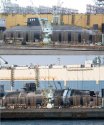The entire dilemma has its roots in the grotesquely expensive (for a licensed production plane) and painstakingly slow proceeding Mitsubishi F-2 project. After all only 98 units (last planes will be produced in FY 08/09) priced at 10-11 bn $ will be procured by JASDF and this number is insufficient to satisfy necessary replacement needs.
They can save a load of money by switching to GEICO ;]
A key issue is, I think, the fact that the Typhoon was originally designed to counter Soviet fighters. Although it has moved towards a multi-role platform, it still has a first-class air-to-air ability. Not to say Rafale isn't good in that role, but I think it's fair to say that Typhoon is better.
I'm not really sure about the last part.
Rafale's selling point is that its multi-role aspects are more mature. But that isn't quite what Japan needs right now.
Actually that is what Japan needs right now.
Also, the Eurofighter consortium has come up with plans for Japan to manufacture its own "customised" Typhoon that would best suit its needs,
Which can add another 5 to 10 years before you actually start producing a plane.
So it's really a competition between Typhoon and a Strike Eagle variant.
Strike Eagle with APG-63V3 or V4 would be nice.












